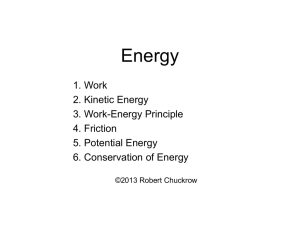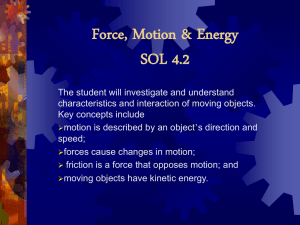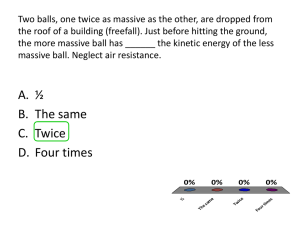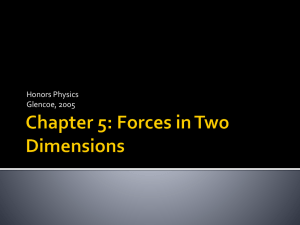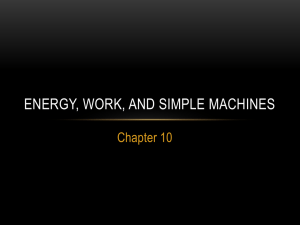Work-Energy Theorem
advertisement
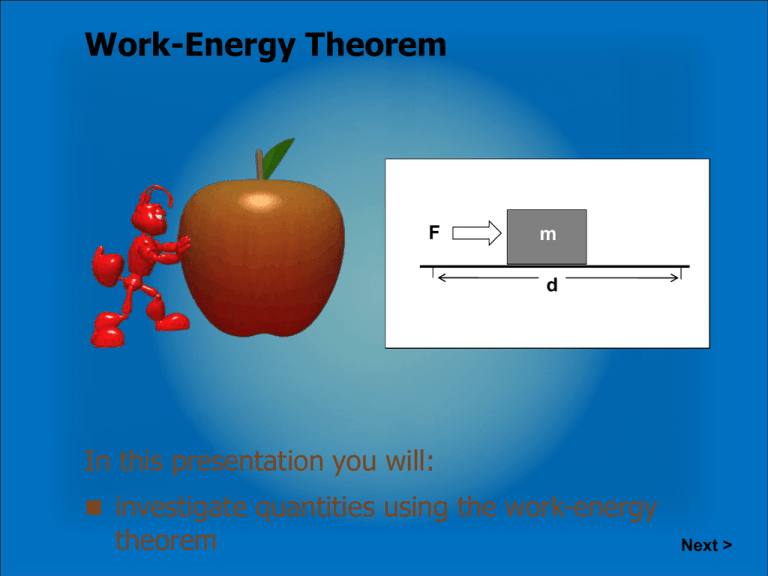
Work-Energy Theorem F m d In this presentation you will: investigate quantities using the work-energy theorem Next > Introduction Many words used in everyday conversation have very precise meanings in physics. When you think of work, you may think of going to a place of work, or working hard, or even something like a computer working. When you think of energy, you may think of how lively or tired you are. In physics, work and energy have very specific meanings. Next > What is work? Consider a force (F) acting on an object while it moves a distance (d). The object’s velocity will change; it will accelerate. a = F/m Using the equations of motion, we can find the change in velocity. vf2 – vi2 = 2ad F m d vf vi m m d Replacing a = F/m and multiplying both sides by m/2, we get: Fd = ½mvf2 – ½mvi2 Next > What is work? Fd = ½mvf2 – ½mvi2 m The left side of the equation is the work done on the system. vf vi m F d In physics, work has a precise definition: Work is the product of force × distance. Work = F × d So: W = ½mvf2 – ½mvi2 Next > Energy W = ½mvf2 – ½mvi2 The right side of the equation describes the change in quantity before and after the force acts. vf vi m m F d The quantity depends on the mass and the velocity of the object. This quantity is known as energy and as it is the energy of a moving body, kinetic energy. KE = ½mv2 So: W = KEf – KEi Next > Work-Energy Theorem Work is equal to the change in kinetic energy. vf vi m m F W = ΔKE d In physics, the Δ symbol is used to represent a change in something. The units of work and energy are the joule (J), named after the physicist James Joule, who discovered the relationship. 1 J = 1 Nm (Fd) = 1 kgm2/s2 (½mv2) Next > Calculating Work Work is calculated using the equation: W = Fd F m d A force of 10 N is used to move an object over a distance of 10 m. How much work is done? W = Fd = 10 × 10 = 100 J Work = 100 J Next > Question 1 How much work is done when a force of 25 N is used to move an object a distance of 5 m? Give your answer as a number in J. Next > Question 1 How much work is done when a force of 25 N is used to move an object a distance of 5 m? W = F × d = 25 × 5 = 125 J Work = 125 J Give your answer as a number in J. 125 (J) Next > Friction Force In the real world, friction tends to act on a moving body to slow it down. Ff F m Now we have a friction d force (Ff ) acting in the opposite direction. Ff acts in the opposite direction, so it does negative work. F m f W = (F – Ff )d d If the friction force Ff was the only force acting on the object when it is in motion, the object would slow down, and its kinetic energy would be reduced. W = (0 - Ff )d = - Ff d Next > Question 2 An object is in motion. A friction force of 10 N acts on it over a distance of 10 m. How much work is done on the object? Give your answer as a number in J. Next > Question 2 An object is in motion. A friction force of 10 N acts on it over a distance of 10 m. How much work is done on the object? W = -Ff × d = -10 × 10 = -100 J Work = -100 J Give your answer as a number in J. -100 (J) Next > Question 3 An object is in motion. A friction force of 10 N acts on it over a distance of 10 m. What is its change in kinetic energy? Give your answer as a number in J. Next > Question 3 An object is in motion. A friction force of 10 N acts on it over a distance of 10 m. What is its change in kinetic energy? W = -Ff × d = -10 × 10 = -100 J Work = -100 J Work = ΔKE ΔKE = -100 J Give your answer as a number in J. -100 (J) Next > Question 4 A force of 100 N is used to move an object over a distance of 10 m. A friction force of 10 N is acting on the object to slow it down. What is the work done? Give your answer as a number in J. Next > Question 4 A force of 100 N is used to move an object over a distance of 10 m. A friction force of 10 N is acting on the object to slow it down. What is the work done? W = (F-Ff ) × d = (100 – 10) × 10 = 900 J Work = 900 J Give your answer as a number in J. 900 (J) Next > Question 5 A moving object has a kinetic energy of 100 J. A force of 30 N is applied to the object in the same direction as its travel over a distance of 10 m. What is the total kinetic energy after 10 m? Give your answer as a number in J. Next > Question 5 A moving object has a kinetic energy of 100 J. A force of 30 N is applied to the object in the same direction as its travel over a distance of 10 m. What is the total kinetic energy after 10 m? W = F × d = 30 × 10 = 300 J Work = 300 J Work = ΔKE ΔKE = 300 J Total KE = 300 + 100 = 400 J Give your answer as a number in J. 400 (J) Next > Force at an Angle Enrichment To calculate force applied at an angle, the force is split into x and y components. Only the component of the force that acts in the direction of the displacement is used. F m d Fx Fx = F cosθ So, W = Fd cosθ θ Fy F The Fy component acts at right angles to the direction of displacement so no work is done. Next > Force at an Angle Enrichment For example, if the force of 10 N is acting at an angle of 30° over a distance of 10 m: W = Fd cosθ F m d W = 10 × 10 × cos30° J Fx θ W = 86.6 J Fy F Next > Summary In this presentation you have seen: Work is an energy transfer calculated by the product of a force and distance. W=F×d The kinetic energy of a moving body is related to its mass and velocity. KE = ½mv2 The work-energy theorem relates work and energy. W = ΔKE End >
